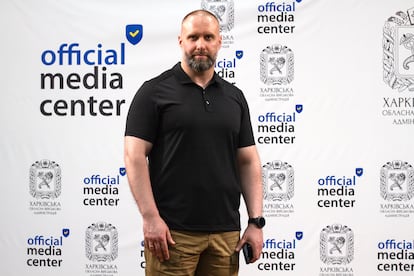Oleh Synyehubov, governor of Kharkiv: ‘This is the border between democratic civilizations and the enemy’
The political leader of one of the provinces hardest hit by the Russian invasion says that military aid and permission from the Western allies to attack targets on enemy soil are yielding results


“I don’t know” are three words that spoken together are very unusual for Oleh Synyehubov, who has served as the governor of Kharkiv since 2021. The politician — who is also a lawyer, researcher and businessman — rarely gives interviews and rarely smiles, say those who know him, but almost always provides a clear and thoughtful answer to everything. Almost always, because the “I don’t know” that escapes his lips with an unexpected half-smile is all he manages to say when asked what his secret is, as he is one of the few governors of a Ukrainian province still in office since the beginning of the war with Russia.
The province Synyehubov governs, partially occupied by Moscow in the first months of the full-scale invasion of February 2022, was liberated in September of the same year, but since May it has been under Russian siege again on several fronts in the north and east, which the Ukrainian army is barely managing to contain. On the humanitarian and military situation in the face of the latest onslaught, he offers full explanations in this interview conducted on August 1 in the press center of his hometown, Kharkiv, the second most-populated city in the country.
Question. What is your main request to the Western allies?
Answer. Kharkiv is sustaining the struggle for democratic values. The first request is, of course, to not stop providing humanitarian support, because Kharkiv right now is the border between democratic civilizations and the enemy, who is trying to attack everybody. Our allies also have to be aware that military aid is extremely necessary and has to be consolidated to make our army as effective as possible on the battlefield, because we are fighting for everybody; we are fighting for the freedom of the whole of Europe.
Q. Have you noticed results after the U.S. and other allied countries authorized you to attack targets in Russian territory with NATO weapons?
A. Yes, we have noticed concrete results both from the military assistance and from that decision: the situation changed because our Armed Forces destroyed everything near the border, such as S-300 and S-400 missile launchers with which they were firing on Kharkiv. For a month now, we have not registered any attacks with these weapons on the [regional] capital, although in the rest of the region they sometimes still use them. This is a concrete result of the decisions that were made to let us fire on their territory. Now, in order to continue defending ourselves, we have to strongly reinforce our air defenses.
Q. What is the situation after the attacks that the city and the province have been the target of since May?
A. The situation in the whole of Kharkiv is changing because we are under attack in the smaller towns, but also in the capital, including with very dangerous guided aerial bombs, such as the FAB-500, which the invading army has also used over the center of Kupiansk. Moreover, they constantly modify them. At first, they had a range of 40 kilometers, but now they can reach up to 80 kilometers or even more, that is to say they can reach city of Kharkiv from any point. On the other hand, the enemy is increasingly directing its FPV [remotely piloted] drones at the civilian population. We have registered more than 500 cases in recent months. This is targeted terrorism because the drone operator can see what target he is hitting; therefore, they are deliberately choosing to attack civilians. As for the front line, we have ongoing hostilities in the direction of Liptsi and Vovchansk in the north of the province and Kupiansk in the east, with fighting every day. The enemy is still trying to penetrate deeper into our territory, but so far has not succeeded.
Q. What has been the response, both humanitarian and military?
A. Since May, when the latest offensive began, we have evacuated about 13,000 people from the Liptsi, Vovchansk, and Kupiansk districts, more than 1,000 of whom were minors. Currently, we are evacuating 38 neighborhoods in five districts and have to forcibly remove about 60 more families, mostly with children, who are in the territories closest to the combat zone, where the threat to the life and health of our population is at its highest. Unfortunately, there are still many people who do not want to be evacuated, but we are conducting operational search activities to identify them and try to move them to a safer place.
Q. Is there any truth in the news circulating that the city of Kharkiv will also be evacuated?
A. It is false, a rumor coming from the invader. We have been fighting against fake news coming from the Russian Federation since 2022, as they constantly outline narratives about the capture of the city of Kharkiv, but there is no reason for the population to leave. However, we take all these threats as absolutely real, because the enemy does not cease in its efforts to seize our territories. And, of course, Kharkiv is a priority target.
Q. Russia has left Ukraine with less than half of its power generation capacity through its attacks on major infrastructure, and the whole country has been suffering from blackouts all summer, including Kharkiv, where the heating system is 52% ready according to your administration’s data. How are you preparing for the winter?
A. We have to restore everything we have lost this year. And, of course, we have to think about how to protect the facilities from being attacked. We are decentralizing new equipment, heating systems, electricity supply, etc. We are preparing according to plan, but we cannot make forecasts because at any moment another massive attack can be launched against our energy system.
Sign up for our weekly newsletter to get more English-language news coverage from EL PAÍS USA Edition
Tu suscripción se está usando en otro dispositivo
¿Quieres añadir otro usuario a tu suscripción?
Si continúas leyendo en este dispositivo, no se podrá leer en el otro.
FlechaTu suscripción se está usando en otro dispositivo y solo puedes acceder a EL PAÍS desde un dispositivo a la vez.
Si quieres compartir tu cuenta, cambia tu suscripción a la modalidad Premium, así podrás añadir otro usuario. Cada uno accederá con su propia cuenta de email, lo que os permitirá personalizar vuestra experiencia en EL PAÍS.
¿Tienes una suscripción de empresa? Accede aquí para contratar más cuentas.
En el caso de no saber quién está usando tu cuenta, te recomendamos cambiar tu contraseña aquí.
Si decides continuar compartiendo tu cuenta, este mensaje se mostrará en tu dispositivo y en el de la otra persona que está usando tu cuenta de forma indefinida, afectando a tu experiencia de lectura. Puedes consultar aquí los términos y condiciones de la suscripción digital.
More information
Archived In
Últimas noticias
Most viewed
- Sinaloa Cartel war is taking its toll on Los Chapitos
- Oona Chaplin: ‘I told James Cameron that I was living in a treehouse and starting a permaculture project with a friend’
- Reinhard Genzel, Nobel laureate in physics: ‘One-minute videos will never give you the truth’
- Why the price of coffee has skyrocketed: from Brazilian plantations to specialty coffee houses
- Silver prices are going crazy: This is what’s fueling the rally









































